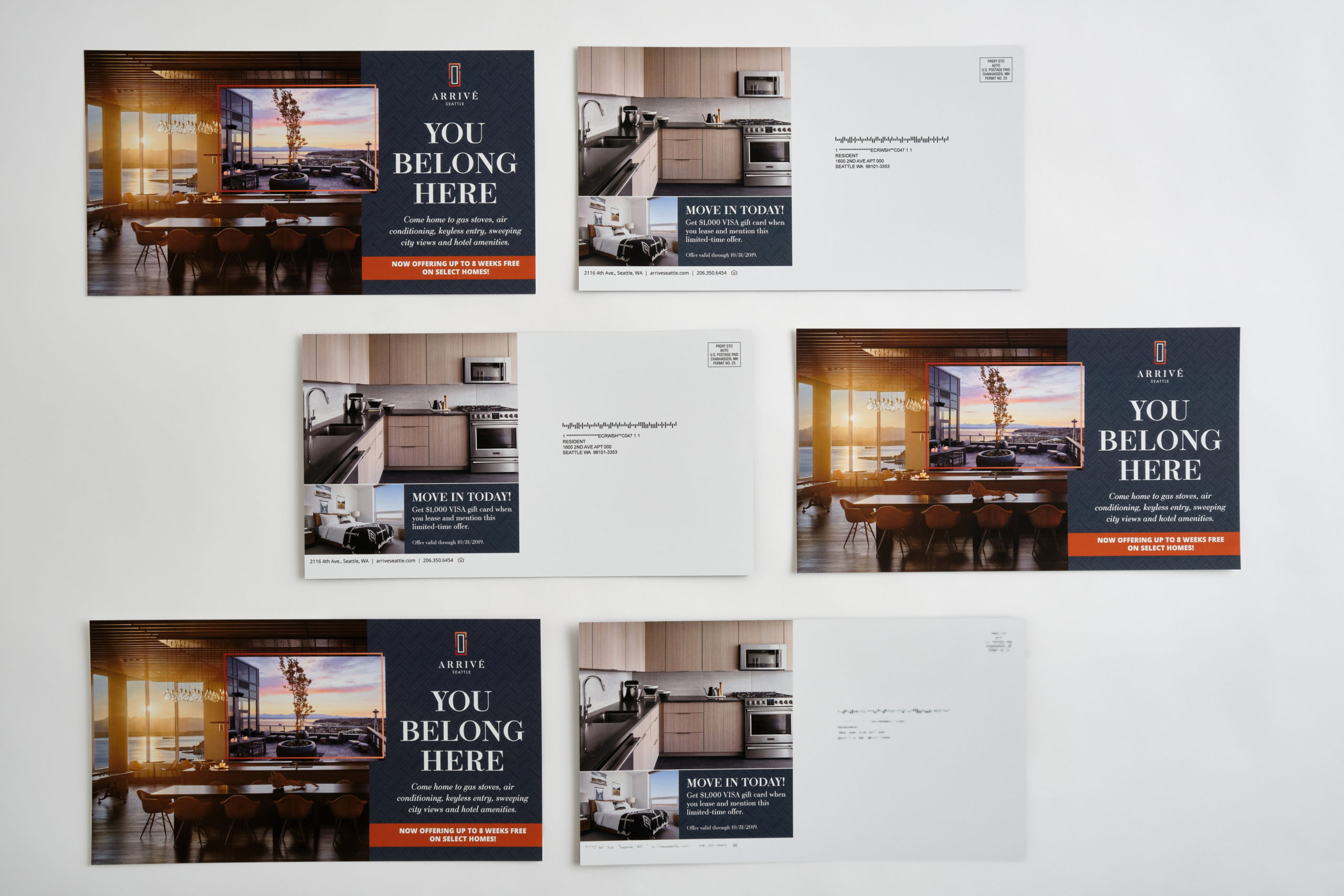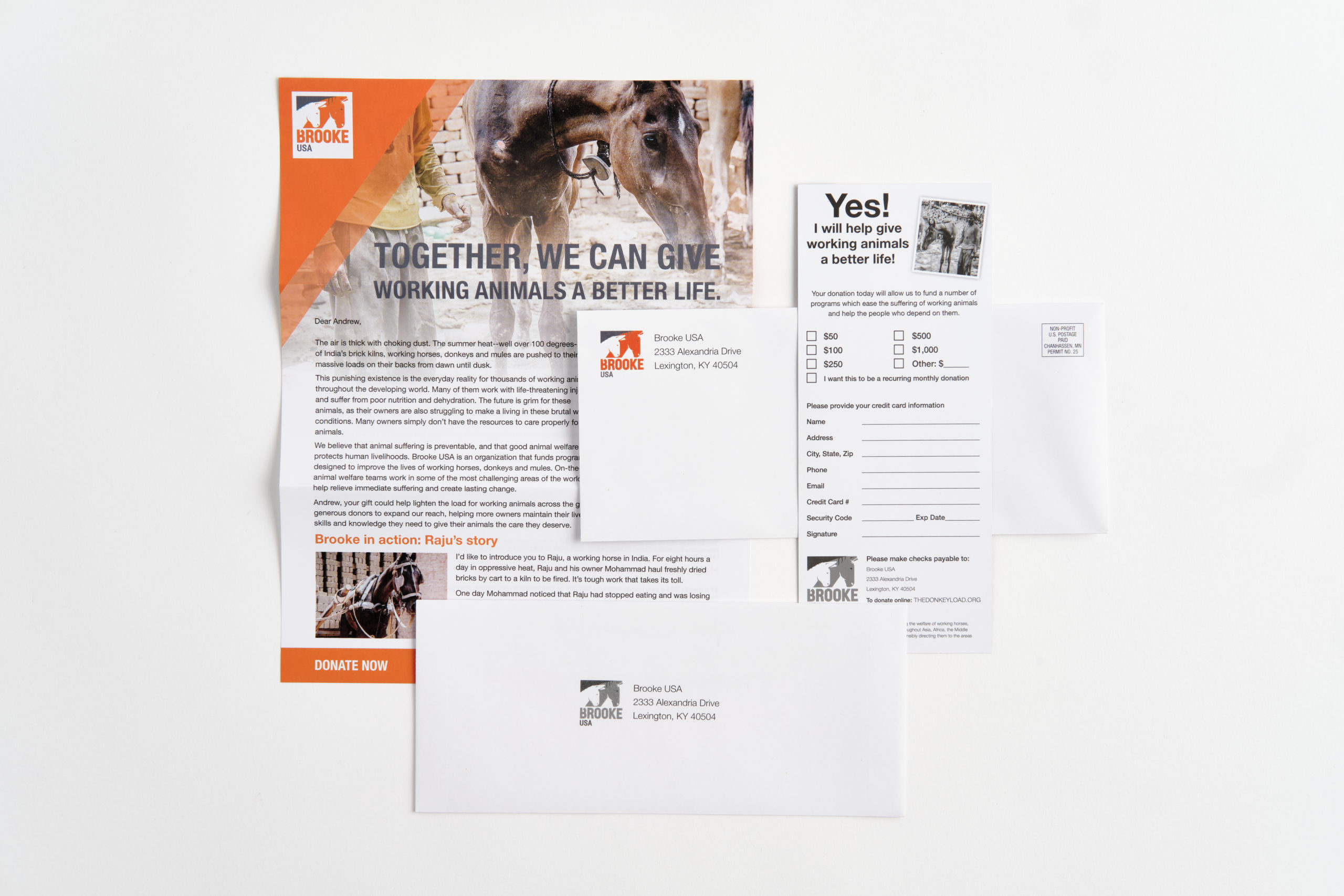Mailing Design Guidelines
What are The Most Important Mailing Design Guidelines for USPS-Approved Direct Mail?
To meet USPS-approved direct mailing design guidelines, your designs must keep all important text and images at least 1/16″ from the edges to avoid being trimmed. Address, return address and postage must be oriented parallel to the longest edge, with a 1″ × 1″ clear space in the top-right corner for postage or indicia. For self-mailers, the recipient address should be no more than 2-3/4″ from the bottom edge.
Following the design guidelines below in detail will ensure that USPS accepts them and enhance the likelihood they’re delivered successfully to intended recipients.
Though many of the standards for each type of mailing piece are similar, there are specific mailing guidelines for each one that you’ll want to follow. Before you send out your direct mail campaigns, check out our tips for designing your mailers correctly, from postcards and envelopes to self-mailers and booklets.
Best Design Guidelines for Mailing Postcards
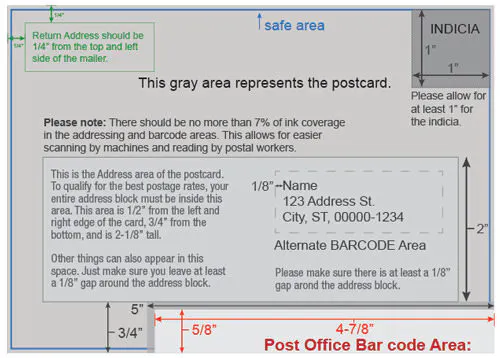
When creating direct mail postcards for online printing, follow the design guidelines below and view our free downloadable postcard mailing template.
What are the Dimensions for Mailing a Postcard?
- Direct mail postcards must be at least 3-1/2” x 5”. To qualify for First Class rates, they can be no larger than 6” x 9”. For Standard rates, they can be no larger than 6-1/8″ x 11-1/2″.
- Smartpress Tip: Keep any wording, logos or other important art 1/8” from the edge. If it’s closer than that, it may get trimmed off during the printing process.
How to Properly Address Postcards
- The address can be placed anywhere within a specific space on the postcard. This area is 1/2” from the left and right edges, 3/4” from the bottom and is 2-1/8” tall.
- If a return address is included, it should be located 1/4” from the top left side of the postcard.
- There should be no more than 7% of ink coverage in the addressing areas to ensure scanning machines and postal workers can read it easily.
- Addressing should be black in order to get the best postage rates.
Postage and Barcode Specifications for Mailing Postcards
- Leave a 1” x 1” space in the upper right-hand corner of the design on the front for postage or indicia.
- There should be no more than 7% of ink coverage in the barcode areas to ensure scanning machines and postal workers can read it easily.
- The Intelligent Mail barcode is approximately 3” x 5/8” and can be included in the address block if there is at least 3-1/2” of horizontal space available in the address area.
- We suggest a two-sided UV coating to fully protect your printed piece.
- Smartpress Tip: If you’re adding stamps and messaging after printing, we suggest a one-sided UV coating, as this keeps the art or graphics side intact, while allowing for stamps and personalizing on the uncoated side.
Best Guidelines for Mailing Envelopes
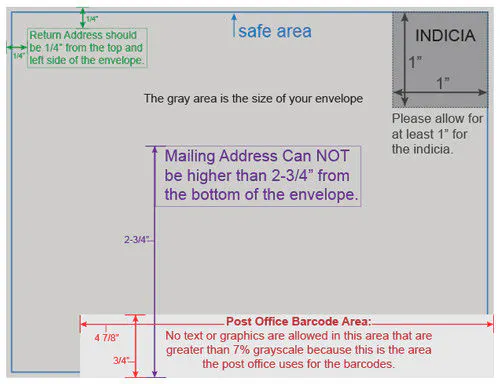
When printing personalized envelopes, follow the design guidelines below and view our free downloadable envelope mailing template.
What are the Dimensions for Mailing an Envelope?
- Envelopes come in standard sizes and vary by product. The dimensions of your design should correspond with the dimensions of the envelope you choose.
- Keep any wording, logos or other important art 1/4” from the edge. If it’s closer than that, it may get trimmed off during the printing process.
How to Properly Address Envelopes
- The top of the mailing address cannot be placed higher than 2-3/4” from the bottom of the envelope.
- The return address should be 1/4” from the top and left side of the envelope.
- There should be no more than 7% of ink coverage in the addressing areas to ensure scanning machines and postal workers can read it easily.
- Smartpress Tip: Addresses should be black in order to get the best postage rates.
Postage and Barcode Specifications for Mailing Envelopes
- Leave a 1” x 1” space in the upper right-hand corner of the design on the front for postage or indicia.
- There should be no more than 7% of ink coverage in the barcode areas to ensure scanning machines and postal workers can read it easily.
- The Intelligent Mail barcode is approximately 3” x 5/8” and can be included in the address block if there is at least 3-1/2” of horizontal space available in the address area.
Best Design Guidelines for Folded Self-Mailers
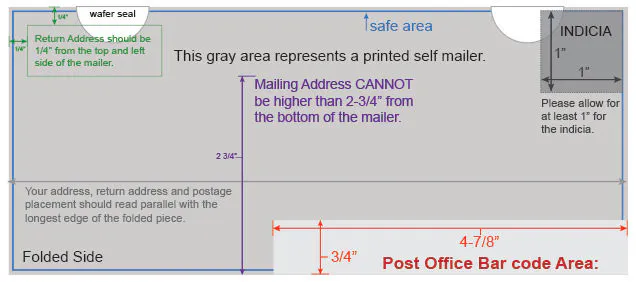
When designing custom brochures and other folded self-mailers with Smartpress’ online printing services, follow the design guidelines below and view our free downloadable self-mailer template.
What are the Dimensions for a Self-Mailer?
- Self-mailers can vary in size but should be rectangular in shape and have a minimum height of 3-1/2” and a maximum height of 6” when folded. The minimum length is 5” and the maximum length is 10-1/2” when folded. Please note “rectangular in shape” means an aspect ratio of between 1.3 to 2.5 when the length is divided by the height.
- Keep any wording, logos or other important art 1/16” from the edge. If it’s closer than that, it may get trimmed off during the printing process.
How to Properly Address Self-Mailers
- The top of the mailing address cannot be placed higher than 2-3/4” from the bottom of the mailer.
- The return address should be 1/4” from the top and left side of the mailer.
- The address and return address should read parallel with the longest edge of the brochure.
- There should be no more than 7% of ink coverage in the addressing areas to ensure scanning machines and postal workers can read it easily.
- Addresses should be black in order to get the best postage rates.
Postage and Barcode Specifications for Self-Mailers
- Leave a 1” x 1” space in the upper right-hand corner of the design on the front for postage or indicia.
- Ensure the postage placement reads parallel with the longest edge of the folded piece.
- There should be no more than 7% of ink coverage in the barcode areas to ensure scanning machines and postal workers can read it easily.
- The Intelligent Mail barcode is approximately 3” x 5/8” and can be included in the address block if there is at least 3-1/2” of horizontal space available in the address area.
Do Self-Mailers Need Wafer Seals?
- Folded and/or stitched mailers require wafer seals (also known as tabs) to hold them closed during postal processing. Wafer seals are typically placed at the short ends of the mailer (see diagram above).
- Choose two wafer seals for anything under 11-1/2″ x 6-1/8″. Over that size, wafer seals are optional.
- Add an additional wafer seal if:
- Your piece is under 11-1/2″ x 6-1/8″ and has more than three folded panels
- Your piece is under 11-1/2″ x 6-1/8″ and weighs more than 1 oz.
- Smartpress Tip: Wafer seals are an additional branding opportunity. Consider designing a custom wafer seal with your logo, initials or brand colors for an immersive experience.
Best Design Guidelines for Booklets
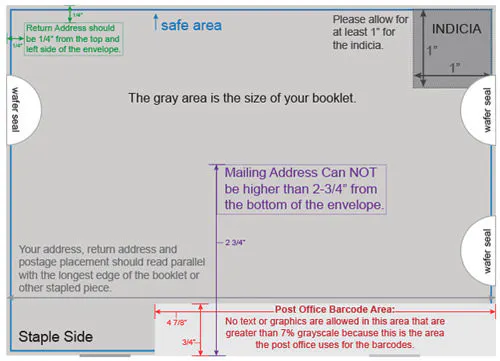
When printing booklets and other stapled mail pieces, follow the design guidelines below and view our free downloadable booklet printing template.
What are the Dimensions for Mailing a Booklet?
- Booklets mailing at Letter postage rates may vary in size, but they must be rectangular in shape with an aspect ratio of between 1.3 to 2.5 when the length is divided by the height. The minimum size is 3-1/2″ x 5″ and the maximum size is 6″ x 10-1/2″.
- Booklets mailing at Letter rates must be wafer-sealed prior to mailing. Square booklets smaller than 6″ x 6″ are subject to additional non-automated postage fees.
- Booklets larger than 6″ x 10-1/2″ are subject to Flat postage rates. The maximum size Smartpress offers is 12″ x 12″. Square booklets larger than 6-1/8″ x 6-1/8″ mail at Flat rates and are not subject to additional fees.
- Smartpress Tip: Keep any wording, logos or other important art 1/16” from the edge. If it’s closer than that, it may get trimmed off during the printing process.
How to Properly Address Booklets
- Booklet mailers will be processed by length by the postal service. This means that your address and return address should read parallel with the longest edge of the booklet.
- The top of the mailing address cannot be placed higher than 2-3/4” from the bottom of the mailer.
- The return address should be 1/4” from the top and left side of the mailer.
- There should be no more than 7% of ink coverage in the addressing areas to ensure scanning machines and postal workers can read it easily.
- Addresses should be black in order to get the best postage rates.
Postage and Barcode Specifications for Mailing Booklet
- Leave a 1” x 1” space in the upper right-hand corner of the design on the front for postage or indicia.
- Ensure the postage placement reads parallel with the longest edge of the booklet.
- There should be no more than 7% of ink coverage in the barcode areas to ensure scanning machines and postal workers can read it easily.
- The Intelligent Mail barcode is approximately 3” x 5/8” and can be included in the address block if there is at least 3-1/2” of horizontal space available in the address area.
Does Booklet Mailing Require Wafer Seals?
- Booklets typically require wafer seals (also known as tabs) to hold them closed during postal processing. Wafer seals are typically placed at the short ends of the mailer (see diagram above).
- Choose two wafer seals for anything under 11-1/2″ x 6-1/8″. Over that size, wafer seals are optional.
- Add an additional wafer seal if:
- Your piece is under 11-1/2″ x 6-1/8″ and has more than three folded panels
- Your piece is under 11-1/2″ x 6-1/8″ and weighs more than 1 oz.
Key Takeaways for Mailing Design Guidelines
| Postcards | Envelopes | Folded Self-Mailers | Booklets | |
| Min. Size | 3.5″ x 5″ | Varies by envelope size | 3.5″ x 5″ (folded) | 3.5″ x 5″ |
| Max. Size (Letter Rate) | 6″ x 9″ (First Class), 6-1/8″ x 11.5″ (Standard) | Standard sizes | 6″ x 10.5″ (folded) | 6″ x 10.5″ |
| Max. Size (Flat Rate) | Over 6-1/8″ x 11.5″ | — | Over 6-1/8″ x 11.5″ (optional tabs) | Up to 12″ x 12″ |
| Aspect Ratio | Must be rectangular | Must be rectangular | 1.3 to 2.5 | 1.3 to 2.5 |
| Safe Margin | 1/8″ from edge | 1/4″ from edge | 1/16″ from edge | 1/16″ from edge |
| Address Area Placement | 1/2″ from left/right; 3/4″ from bottom; 2-1/8″ tall | ≤ 2-3/4″ from bottom | ≤ 2-3/4″ from bottom | ≤ 2-3/4″ from bottom |
| Return Address | 1/4″ from top left | 1/4″ from top and left | 1/4″ from top and left | 1/4″ from top and left |
| Ink Coverage (Address) | ≤ 7%, black ink | ≤ 7%, black ink | ≤ 7%, black ink | ≤ 7%, black ink |
| Postage/Indicia Space | 1” x 1” top right corner | 1” x 1” top right corner | 1” x 1” top right corner | 1” x 1” top right corner |
| Barcode | 3” x 5/8”, needs 3.5” horizontal space | 3” x 5/8”, needs 3.5” horizontal space | 3” x 5/8”, needs 3.5” horizontal space | 3” x 5/8”, needs 3.5” horizontal space |
| Barcode Orientation | Parallel to longest edge | Parallel to longest edge | Parallel to longest edge | Parallel to longest edge |
| Wafer Seals Needed? | No | No | Yes, if under 11.5″ x 6.125″ (optional if larger) | Yes, if under 11.5″ x 6.125″ (optional if larger) |
| Extra Tab Required If | — | — | More than 3 panels or over 1 oz. | More than 3 panels or over 1 oz. |
| Coating Suggestion | UV one-sided (for stamps), UV two-sided optional | — | — | — |
If you have questions about these mailing design guidelines, direct mail printing or any of our custom printing services, please contact customer service and chat with our experts.
